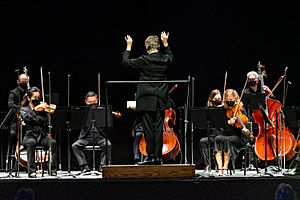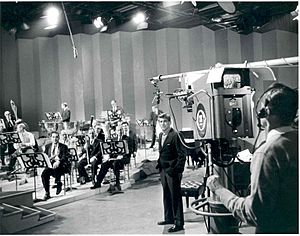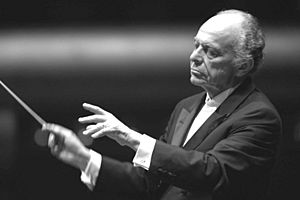New York Philharmonic facts for kids
Quick facts for kids New York Philharmonic |
|
|---|---|
| Orchestra | |

The orchestra at The Shed, Hudson Yards New York, NY, April 2021
|
|
| Founded | 1842 |
| Location | New York, United States |
| Concert hall | David Geffen Hall at Lincoln Center |
| Principal conductor | Jaap van Zweden |
The New York Philharmonic is a famous symphony orchestra in New York City. It's also known as the New York Philharmonic Orchestra (NYPO). This orchestra is one of the best in America. People often call it one of the "Big Five" orchestras.
The Philharmonic plays its concerts at David Geffen Hall. This hall is part of the Lincoln Center for the Performing Arts in New York. The New York Philharmonic is one of the oldest music groups in the United States. It's the oldest of the "Big Five" orchestras. In December 2004, they played their 14,000th concert! That's a lot of music!
The orchestra began in 1842. Back then, it was called the Philharmonic Society. Their first concert featured a very long program. It included Beethoven’s Symphony No. 5. Ureli Corelli Hill conducted this first performance. The musicians worked together like a team. They decided how the orchestra would be run. This included who could join and what music they would play. At the end of each season, they shared any money they earned.
Contents
- Beethoven's Ninth Symphony and a New Home (1846)
- New Orchestras and Famous Conductors (1878)
- A New Way to Run the Orchestra (1909)
- Joining Forces and Reaching Out (1921)
- The War Years (1940)
- The TV Age (1950)
- Traveling the World
- A New Century (2000)
- Music Directors Through the Years
- Special Roles
- Awards and Honors
- Images for kids
- See also
Beethoven's Ninth Symphony and a New Home (1846)
The orchestra was very successful. But they needed a bigger place to play. They held a special concert to raise money. This concert featured Beethoven's Symphony No. 9. It was the first time this symphony was played in America.
The concert happened at Castle Garden in Manhattan. About 400 musicians and singers performed. The choir's words were sung in English. This was the first time this work was sung in English anywhere. Tickets were expensive, costing US$2.00 each. So, not many people came. It took a while for the orchestra to get its own concert hall.
Many people thought Beethoven's 9th symphony was unusual. This is because the choir only sings in the last part, called "Ode to Joy". In 1865, Theodore Eisfeld conducted a concert for Abraham Lincoln. Lincoln had recently been killed. But the "Ode to Joy" part was not played. People felt it wasn't right for such a sad event.
New Orchestras and Famous Conductors (1878)
Leopold Damrosch was the orchestra's conductor in 1876-1877. He had been a top musician for Franz Liszt. But the public didn't like his style. So, he started his own group, the Symphony Society of New York.
When Leopold died in 1885, his 23-year-old son, Walter Johannes Damrosch, took over. He continued to compete with the older Philharmonic. Walter helped convince Andrew Carnegie, a rich man from Scotland, that New York needed a great concert hall. On May 5, 1891, Walter and the Russian composer Tchaikovsky conducted the first concert. It was held in the city's new Music Hall. A few years later, this hall was renamed Carnegie Hall. It was named after Andrew Carnegie, who paid for it.
Theodore Thomas started conducting the Philharmonic in 1877. He made it a very strong orchestra. In 1891, Thomas left New York. He went on to start the Chicago Symphony Orchestra.
Anton Seidl conducted the orchestra until 1898. Seidl had worked with Richard Wagner as his helper. He was famous for conducting Wagner’s music. He also led the first performance of Antonín Dvořák's Ninth Symphony, "From the New World." Many people were sad when Seidl suddenly died in 1898. He was only 47 and died from food poisoning. Twelve thousand people wanted tickets to his funeral. It was held at the Metropolitan Opera House. The streets were full of people and traffic.
A New Way to Run the Orchestra (1909)
In 1909, the orchestra changed how it was run. Instead of musicians making all the rules, a small group of people called guarantors took charge. They convinced Gustav Mahler to become the main conductor.
The orchestra started giving more concerts. They went from 18 concerts a season to 54. This included a tour of New England. Mahler was used to conducting opera. Now, he could conduct symphonies. He also showed audiences his own music. During his time, the musicians got regular paychecks for the first time.
Between 1911 and 1920, Josef Stransky was the Philharmonic's conductor. He led every single concert during those years.
Joining Forces and Reaching Out (1921)
The Philharmonic joined with the National Symphony in 1921. Their new conductor was Willem Mengelberg from the Netherlands. He stayed for nine years. Other famous conductors also led concerts during this time. These included Bruno Walter, Wilhelm Furtwängler, Igor Stravinsky, and Arturo Toscanini.
The orchestra also started playing outdoor summer concerts. These were low-priced shows at Lewisohn Stadium. In 1920, they hired Henry Hadley. He was an "associate conductor" who performed music by American composers.
In 1924, the Young People's Concerts began. These concerts quickly grew to 15 shows per season. The orchestra also started making recordings. In 1928, they joined with another orchestra, the New York Symphony Society. Toscanini conducted this new, combined orchestra. He stayed until 1936.
The War Years (1940)
The English conductor John Barbirolli and Artur Rodzinski from Poland took over from Toscanini in 1936. The next year, Barbirolli became the main conductor. He held this job until 1941. In 1943, Rodzinski became the conductor.
Rodzinski was conducting a Sunday radio show when something big happened. CBS listeners heard an announcer interrupt the music. They were told about the attack on Pearl Harbor.
Artur Rodzinski, Bruno Walter, and Sir Thomas Beecham made many recordings with the Philharmonic. These were for Columbia Records in the 1940s.
The TV Age (1950)
Leopold Stokowski and Dimitri Mitropoulos were the orchestra’s two conductors in 1949. Mitropoulos became the main conductor in 1951. He often conducted new and less-known music. In 1957, Mitropoulos and Leonard Bernstein worked together. Soon after, Bernstein became the main conductor. He was the first American-born and American-trained conductor of the Philharmonic.
Leonard Bernstein was the Music Director for 11 seasons. Many new things happened during his time. Two TV shows started on CBS: the Young People's Concerts and "Leonard Bernstein and the New York Philharmonic." The first of these began in 1958. It was a new idea and won many awards for educational TV. Bernstein continued the orchestra's recordings with Columbia Records. He retired as music director in 1969. He also encouraged many composers, especially American ones like Aaron Copland, to write new music for the orchestra.
In 1971, Pierre Boulez became the first Frenchman to be the Philharmonic's conductor. Boulez had new ideas about what music to play. He was a composer himself and often performed modern music.
Traveling the World
Zubin Mehta became conductor in 1978. He also conducted a lot of new music.
Kurt Masur had often conducted the Philharmonic since 1981. He became the main conductor in 1991. During his time, he started free Memorial Day Concerts. These were held at the Cathedral of St. John the Divine. He also led yearly concert tours abroad. This included the orchestra's first trip to mainland China. He stayed until 2002. Then, he was given the special title “Music Director Emeritus of the Philharmonic.”
On 26 February 2008, the Philharmonic played a concert in Pyongyang, North Korea. This was a very important cultural visit. It was the first time such a visit happened from the United States to North Korea since the Korean War ended in 1953.
A New Century (2000)
In September 2002, Lorin Maazel became the Philharmonic's conductor. He had conducted the orchestra before, at age twelve! In his first week, he conducted the first performance of John Adams' On the Transmigration of Souls. This music was written to remember those who died on September 11, 2001. He performed new music and music by well-known composers. He stayed with the orchestra until the 2008-2009 season.
Recent Conductors and Leaders
On July 18, 2007, the Philharmonic chose Alan Gilbert as its next music director. He started in the 2009/10 season. On May 5, 2010, the New York Philharmonic played its 15,000th concert. No other symphony orchestra in the world has reached this many concerts! In October 2012, Gilbert's contract was extended through the 2016/17 season. In February 2015, the orchestra announced Gilbert would finish his time as music director after the 2016/17 season.
In January 2016, the orchestra announced Jaap van Zweden would be its next music director. He started in the 2018/19 season. In September 2021, van Zweden said he plans to step down after the 2023–2024 season.
Deborah Borda is the current president and CEO of the orchestra. She had held these jobs before. She is scheduled to leave her role on June 30, 2023. In June 2022, the orchestra announced Gary Ginstling would be the next president and CEO. He will start on July 1, 2023.
During the COVID-19 pandemic, the orchestra could not give live concerts. This started in March 2020. David Geffen Hall was renovated during the pandemic. It was planned to reopen for the 2022–2023 season. The orchestra played concerts at other places in New York City in the 2021-2022 season. These included Alice Tully Hall and Carnegie Hall.
In November 2022, for the first time ever, the orchestra had more women than men. There were 45 women and 44 men.
Music Directors Through the Years
|
|
Special Roles
Leonard Bernstein Scholar-in-Residence
This role started in 2005. It honors Leonard Bernstein's memory. The person in this role gives talks each year. They also take part in other New York Philharmonic events. The first person to hold this job was Charles Zachary Bornstein (2005-2008). James M. Keller held the position in 2008–09. Thomas Hampson was appointed in July 2009. The current person in this role is Michael Beckerman.
Composer in Residence
Alan Gilbert created the job of a composer in residence. This is a three-year position.
- Magnus Lindberg (2009–2012)
- Christopher Rouse (2012–2015)
- Esa-Pekka Salonen (2015–2018)
Awards and Honors
The New York Philharmonic has won many awards for its music!
Grammy Award for Best Classical Album
- 1965 Bernstein: Symphony No. 3 "Kaddish"
- 1974 Bartók: Concerto for Orchestra
- 1978 Concert of the Century
- 1991 Ives: Symphony No. 2; Gong on the Hook and Ladder; Central Park in the Dark; The Unanswered Question
- 2005 Adams: On the Transmigration of Souls
Grammy Award for Best Orchestral Performance
- 1990 Mahler: Symphony No. 3 in D Minor
- 1974 Bartók: Concerto for Orchestra
- 1976 Ravel: Daphnis et Chloé
- 2005 Adams: On the Transmigration of Souls
Grammy Award for Best Album for Children
- 1962 Prokofiev: Peter and the Wolf
- 1963 Saint-Saëns: The Carnival of the Animals; Britten: Young Person's Guide to the Orchestra
- 1964 Bernstein: Young People's Concerts
Images for kids
See also
 In Spanish: Orquesta Filarmónica de Nueva York para niños
In Spanish: Orquesta Filarmónica de Nueva York para niños







